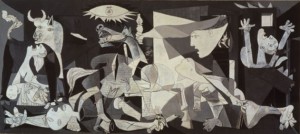It was market day on April 26th 1937 in Guernica, a small town in northern Spain considered to be the spiritual capital of Basque culture.
In late afternoon, without warning or provocation, Luftwaffe aircraft swooped down over Guernica. Wave after wave bombarded the town with huge bombs and more than 3,000 incendiaries. The merciless firestorm destroyed three quarters of the town’s buildings. No one knows how many hundreds, maybe thousands of people were killed or wounded.
This was the height of the Spanish Civil War. Fascist dictator General Franco was waging a campaign against the legitimate elected government and had generously invited his nasty little friend Hitler to practice terror bombing to help demoralise his enemies.
As the flames engulfed Guernica, one of the first on the scene was war correspondent for The Times newspaper, George Steer, who wrote: “The whole town of 7,000 inhabitants, plus 3,000 refugees, was slowly and systematically pounded to pieces.” And so news of the atrocity reached the outside world.
The legitimate Spanish government had commissioned Pablo Picasso to create a mural for the Spanish Pavilion at that summer’s Paris International Exposition. Horrified by news of the annihilation of Guernica, Picasso abandoned his initial idea and immediately began work on a gigantic canvas; 11 feet tall and nearly 26 feet wide. Its scale is important; it makes the scene overwhelming and inescapable, as it was to the victims. He completed his work in a matter of weeks – it is one of the most astonishing, emotionally-charged paintings ever created.
Painted in black and white to mirror newspaper photographs and newsreels of the time, it depicts in grotesque detail the suffering and tragedies of war and its consequences for innocent civilians. A horse run through with spear squeals in agony as it dies from its wounds. A woman is trapped in a burning building; her eyes have turned into tears. A mother cradles the body of her limp, lifeless baby and howls in grief.
A bull silently surveys the scene, symbolising Spain itself and humanity’s domination of nature. The deliberate irony is that since ancient times is it usually the bull who is sacrificed. At the apex of the painting within an eye-shape is a light bulb, perhaps symbolic of the all-seeing media.
And yet there are flickers of hope if you look for them; a little flower and a candle are firmly clutched in the hands of the dying.
In the years since its creation Picasso’s Guernica has lost none of its power. It has gained monumental status, a perpetual reminder of the horrors of war and an embodiment of peace. Indeed the authorities deemed its anti-war message so powerful that a tapestry of the painting, hanging at UN in lead-up to the Iraq war had to be covered for a media conference taking place in front of it.
Artistically, politically, historically, culturally it is surely the most important painting of the 20th century.
[Written by Jane Tomlinson]



2 Responses to 26th April 1937 – Guernica